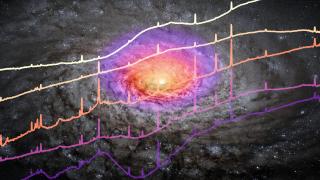Bibcode
Fernández-Torreiro, M.; Cicone, C.; Tadhunter, C. N.; González-Fernández, C.; Acosta-Pulido, J. A.; Ramos Almeida, C.
Bibliographical reference
Monthly Notices of the Royal Astronomical Society: Letters, Volume 487, Issue 1, p.L18-L23
Advertised on:
6
2019
Citations
33
Refereed citations
31
Description
Based on new near-infrared spectroscopic data from the instrument
Espectrógrafo Multiobjeto Infra-Rojo (EMIR) on the 10.4 m Gran
Telescopio Canarias, we report the presence of an ionized and warm
molecular outflow in the luminous type-2 quasar J150904.22+043441.8 (z =
0.1118). The ionized outflow is faster than its molecular counterpart,
although the outflow sizes that we derive for them are consistent within
the errors (1.34 ± 0.18 and 1.46 ± 0.20 kpc,
respectively). We use these radii, the broad emission-line luminosities
and in the case of the ionized outflow, the density calculated from the
trans-auroral [O II] and [S II] lines, to derive mass outflow rates and
kinetic coupling efficiencies. While the ionized and warm molecular
outflows represent a small fraction of the AGN power (≤0.033 and
0.0001 per cent of Lbol, respectively), the total molecular
outflow, whose mass is estimated from an assumed warm-to-cold gas mass
ratio of 6 × 10-5, has a kinetic coupling efficiency of
˜1.7 per cent Lbol. Despite the large uncertainty, this
molecular outflow represents a significant fraction ofLbol
and it could potentially have a significant impact on the host galaxy.
In addition, the quasar spectrum reveals bright and patchy narrow
Paα emission extending out to 4 arcsec (8 kpc) south-east and
north-west from the active nucleus.
Related projects

Nuclear Activity in Galaxies: a 3D Perspective from the Nucleus to the Outskirts
This project consists of two main research lines. First, the study of quasar-driven outflows in luminous and nearby obscured active galactic nuclei (AGN) and the impact that they have on their massive host galaxies (AGN feedback). To do so, we have been granted time with the Gran Telescopio CANARIAS (GTC) in the optical and near-infrared ranges
Cristina
Ramos Almeida